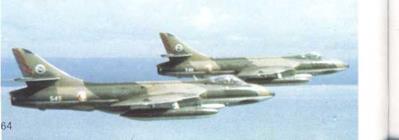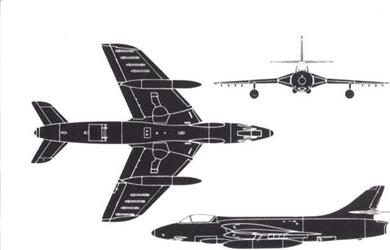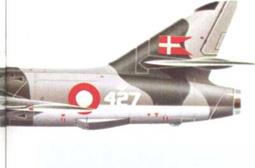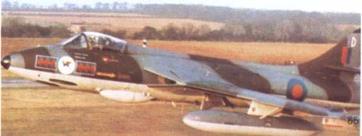HSA (BAe) Hunter
Hunter 1 to 79
Origin: Hawker Aircraft, UK (now British Aerospace): licence-production in Belgium/Netherlands.
Type: Single-seat fighter, fighter-bomber and fighter-reconnaissance: two-seat dual trainer.
Engine: One Rolls-Royce Avon single-shaft turbojet (see text). Dimensions: Span 33ft 8in (10-26m); length (single-seat, typical) 45ft 10Jin (13’98m). (two-seat) 48ft 10Jin (14-9m); height 13ft 2in (4.26m).
Weights: Empty (1) 12,1281b (5501kg): (9) 13,2701b (6020kg): loaded (1) 16,2001b (7347kg): (9, clean) 17,7501b (8051kg): (9, maximum) 24,000lb (10,885kg).
Performance: Maximum speed (typical of all) 71 Omph (11 44km/h) at sea level, 620mph (978km/h, Mach 0-94) at height; initial climb (Avon 100- series) about 5,500ft (1676m)/min; (Avon 200-series) 8,000ft (2438m)/ service ceiling 50,000ft (1 5,240m); range on internal fuel 490 miles (689km), with maximum fuel 1,840 miles (2965km).
Armament: Four (two-seaters, usually one, sometimes two) 30mm Aden cannon beneath cockpit floor, each with 150 rounds; single-seaters normally have underwing pylons for two 1,0001b (454kg) bombs and 24 3in rockets, later or refurbished aircraft carrying two 230 Imp gal drop tanks in addition.
History: First flight (P.1067) 20 June 1951; (production F.1) 16 May 1953; (two-seater) 8 July 1955: final delivery from new. 1966.
Users: Abu Dhabi, Chile, India, Iraq, Kenya, Kuwait, Lebanon, Oman, Peru, Qatar, Singapore, Switzerland, UK (RAF, Royal Navy), Zimbabwe – Rhodesia.
Development: Undoubtedly the most successful British post-war fighter, the Hunter epitomised the grace of a thoroughbred and has always delighted its pilots. The prototype, with 6.500lb thrust Avon 100, was built to Specification F.3/48. It was easily supersonic in a shallow dive and packed the devastating four Aden cannon in a quick-release pack winched up as a unit. After being fitted with bulged cartridge boxes and a stuck-on airbrake under the rear fuselage it became a standard fighter, with Armstrong Whitworth building the F.2 with 8,000lb Sapphire 101, wnich, unlike the early
 Below: A brace of Hunter F.74B single seaters of the Singapore Air Defence Command, one of the last and most satisfied Hunter customers.
Below: A brace of Hunter F.74B single seaters of the Singapore Air Defence Command, one of the last and most satisfied Hunter customers.


Three-view of Hunter FGA.9. typical of most single-seaterstoday.
Avon, stayed going when the guns were fired. The one-off Mk 3 gained a world speed record at 727-6mph, the F.4 had fuel capacity raised from 334 to 414 gal and carried underwing stores, and the F.5 was a Sapphire – engined 4. The F.6 introduced the 10,0001b Avon 203 and extended-chord dog-tooth wing. The T.7 had the 8,0001b Avon 122 and side-by-side dual controls, the T.8 was a naval trainer, and the most important mark of all was the FGA.9 with 10,1501b Avon 207 and heavier underwing load. The FR.10 was a camera-equipped fighter and the GA.11 was a ground-attack naval trainer. Total Flunter production was 1,985, including 445 made in Belgium and Holland. While 429 were exported as new aircraft, well over – 700 additional Hunters have been refurbished or completely remanufactured for more than 17 air forces, with mark numbers up to 79, Д superb all-round combat aircraft, it is gradually being recognised that, had a further 1,000 been constructed (or fewer scrapped in Britain) all would have found ready buyers today.
 Left: This Hunter F.51 was one formerly used by the Royal Danish Air Force (724 Sqn).
Left: This Hunter F.51 was one formerly used by the Royal Danish Air Force (724 Sqn).
 |
Below: Takeoff by a Hunter FGA.9 of No 45 Sqn RAF, one of the last units to have operated this outstanding aircraft in Britain.










